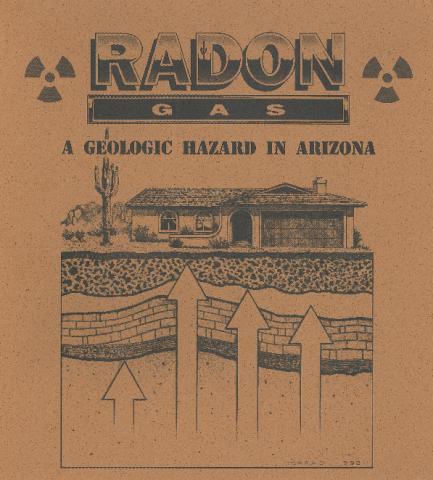Rundown on Radon
Radon (Rn) - Atomic Mass: 86; Atomic Number: 222
Radon (Rn) is a noble (inert) gas formed by radiogenic decay of uranium. It's a colorless and odorless radiogenic gas. Radon's most common radiogenic isotope, 222Rn, has a half-life of 3.8 days; one half-life is the period of time during which one-half of the parent isotope decays to form daughter isotopes. (So if you began with 1000 222Rn, 3.8 days later, you would have 500 222Rn isotopes and 500 daughter isotopes). 222Rn decays spontaneously to form daughter isotopes that decay to form a stable lead end-product.
Impacts on People, Property and Infrastructure
Radon is the second cause of lung cancer in the U.S., resulting in more than 21,000 deaths annually (EPA - Health Risk of Radon). Fortunately, indoor radon levels in Arizona are among the lowest in the U.S. In the late 1980’s and early 1990’s, AZGS geoscientists, led by senior geologist, Jon Spencer, made a concerted effort to understand the geologic hazard of radon in Arizona, resulting in Radon Gas - A Geologic Hazard in Arizona.
Radon levels in Arizona are generally low, there are, however, several hot spots throughout the state. Some of the more prominent radon hot spots include: Tucson (the area around Cardinal Avenue); the Cave Creek Area; parts of the Verde Valley; and the Granite Dells near Prescott. The US EPA recommends that all homes be tested for radon levels. The U.S. Environmental Protection Agency has a web page, Radon, dedicated to assessing and mitigating radon in your home.
From Arizona Bureau of Radiation Control radon primer.
- Elevated levels of radon are found in both new and old buildings.
- Radon can be found in homes built on all types of foundations, including crawlspaces and slab-on-grade basements.
- The percentage of Arizona homes that contain radon above recommended levels is similar to U.S. average.
- The average radon level found in homes in the U.S. is about 1.4 pCi/L. In Arizona, the median of radon levels found in 4000+ homes during the state indoor radon survey (1987-89) was about 1.6 pCi/L.
- Sub-floor ductwork for forced air furnaces and air conditioners can draw radon-laden soil gas into a home.
- Radon levels in Arizona can often be higher in the summer air conditioning months than during months with milder temperatures.
 s.
s.
Geoscience at Work for Arizona
AZGS is not currently engaged assessing radon concentration or hazards. The Arizona Bureau of Radiation Control does, however, offer select services for radon, including:
- Primer on radon
- Free radon testing kit
- Health risks
- Radon in water
- Frequently asked questions (FAQ)

